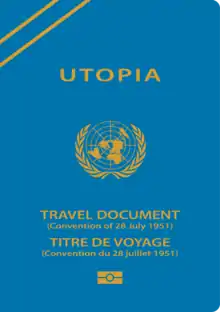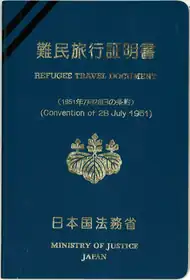


A refugee travel document (also called a 1951 Convention travel document or Geneva passport) is a travel document issued to a refugee by the state which they normally reside in, allowing them to travel outside that state and to return there. Refugees are unlikely to be able to obtain passports from their state of nationality (from which they have sought asylum) and therefore need travel documents so that they might engage in international travel.
The 145 states which are parties to the 1951 Convention Relating to the Status of Refugees are obliged to issue travel documents to refugees lawfully resident in their territory.[1]
Refugee travel documents are passport-like booklets. Their cover bears the words "Travel Document" in English and French (and often in the language of the issuing state), as well as the date of the convention: 28 July 1951. The documents were originally grey, though some countries now issue them in other colours, with two diagonal lines in the upper left corner of the front cover. Bearers enjoy certain visa-free travel privileges extended by signatories to the convention.
However, as a refugee travel document is not a regular national passport, some problems may be encountered by the holder from time to time, for example due to non-familiarity of airline staff with such documents.[2][3][4]
Travel documents issued to refugees
- New Zealand Refugee Travel Document
- Estonian travel document for refugees
- U.S. Refugee Travel Document (United States) visa not required for Germany, Netherlands, Belgium, Croatia, Slovenia, Slovakia, Hungary and Cyprus.[5]
- Australian Convention Travel Document. This document by itself does not allow the bearer to return to Australia; for that, a separate visa must be obtained.[6]
- Swiss Travel Document
Limitations of a refugee travel document compared to a passport
- Refugee travel documents issued by the Government of Canada cannot be used for travel to the bearer’s country of citizenship,[7] and a refugee travel document issued by another country is not treated as a valid passport for the purposes of obtaining an Electronic Travel Authorization to visit Canada. Given that bearers of refugee travel documents are not citizens of the issuing country they may need to apply for a visa before travelling to Canada.[8]
- Egyptian travel documents issued for Palestinian refugees are considered unacceptable travel documents for travel and entry to New Zealand, unless they include an entry visa allowing the holder to enter Egypt.[9]
Gallery of Refugee Travel Documents
 New Zealand Refugee Travel Document
New Zealand Refugee Travel Document Canadian Refugee Travel Document
Canadian Refugee Travel Document Irish Refugee Travel Document
Irish Refugee Travel Document Japanese Refugee Travel Document
Japanese Refugee Travel Document Australian Refugee Travel Document
Australian Refugee Travel Document Ukrainian Refugee Travel Document
Ukrainian Refugee Travel Document United States Travel Document
United States Travel Document German Refugee Travel Document
German Refugee Travel Document Lithuanian Refugee Travel Document
Lithuanian Refugee Travel Document Russian Refugee Travel Document
Russian Refugee Travel Document Swiss Refugee Travel Document
Swiss Refugee Travel Document British Refugee Travel Document
British Refugee Travel Document
See also
- Australian Convention Travel Document
- Refugee identity certificate
- Travel document
- 1954 Convention Travel Document, for stateless persons
- Certificate of identity, for stateless persons or others
- Nansen passport, the predecessor of the refugee travel document
National non-citizen travel documents
- Canadian Certificate of Identity
- Japan Re-entry Permit
- Australian Certificate of Identity. This document by itself does not allow the bearer to return to Australia; for that, a separate visa must be obtained.[10]
Footnotes
- ↑ Under Article 28 of the Convention.
- ↑ Questions over refugee holiday process after Syrian family blocked after leaving Australia
- ↑ Thailand Should Return Football Player Refugee To Australia, Not Bahrain
- ↑ Ryanair apologizes for preventing refugee from boarding flight
- ↑ Travel Documents, USCIS
- ↑ Convention Travel Documents (CTD) Archived 2013-03-04 at the Wayback Machine
- ↑ "Types of passports and travel documents". Government of Canada. 2015-06-26. Retrieved 2015-12-09.
- ↑ "Apply for an Electronic Travel Authorization (eTA)". Government of Canada. 2015-11-18. Retrieved 2015-12-09.
- ↑ "A2.15 Unacceptable travel documents". immigration.govt.nz. Immigration New Zealand. April 8, 2013.
- ↑ Certificate of Identity(COI) Archived 2013-03-04 at the Wayback Machine
External links
- Travel documents from Immigration, Refugees and Citizenship Canada
- 1951 Convention travel document Images from Passportland.com